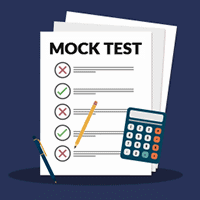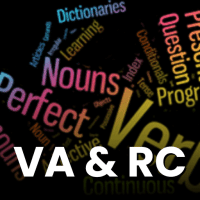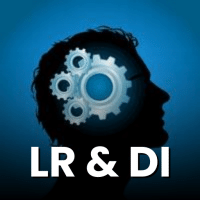CAT Exam > CAT Questions > Directions: This data sufficiency problem co...
Start Learning for Free
Directions: This data sufficiency problem consists of a question and two statements labelled (A) and (B). You have to decide whether the data given in the statements is sufficient for answering the question.
AB and CB are two-digit numbers. What digit is represented by A?
(A) AB + CB = 66
(B) AB – CB = 20
- a)Statement (A) alone is sufficient, but statement (B) alone is not sufficient to answer the question asked.
- b)Statement (B) alone is sufficient, but statement (A) alone is not sufficient to answer the question asked.
- c)Both statements (A) and (B) together are sufficient to answer the question asked; but neither statement alone is sufficient.
- d)Each statement alone is sufficient to answer the question asked.
- e)Statements (A) and (B) together are not sufficient to answer the question asked, and additional data relevant to the problem is needed.
Correct answer is option 'C'. Can you explain this answer?
Most Upvoted Answer
Directions: This data sufficiency problem consists of a question and ...
Explanation:
Statement (A): AB + CB = 66
- From this equation, we can determine the value of the tens digit in both AB and CB.
- However, we cannot determine the value of the units digit in either AB or CB.
- This statement alone is not sufficient to determine the digit represented by A.
Statement (B): AB - CB = 20
- Similar to Statement (A), this equation allows us to find the tens digit in both AB and CB.
- Again, we cannot determine the units digit in either AB or CB.
- This statement alone is also not sufficient to determine the digit represented by A.
Both Statements Together:
- When we consider both equations (A) and (B) together, we can solve for the tens digit and the units digit in both AB and CB.
- By finding the difference between the tens digits of AB and CB, we can determine the value of A.
- Therefore, both statements together are sufficient to answer the question.
Therefore, the correct answer is option 'C'.
Statement (A): AB + CB = 66
- From this equation, we can determine the value of the tens digit in both AB and CB.
- However, we cannot determine the value of the units digit in either AB or CB.
- This statement alone is not sufficient to determine the digit represented by A.
Statement (B): AB - CB = 20
- Similar to Statement (A), this equation allows us to find the tens digit in both AB and CB.
- Again, we cannot determine the units digit in either AB or CB.
- This statement alone is also not sufficient to determine the digit represented by A.
Both Statements Together:
- When we consider both equations (A) and (B) together, we can solve for the tens digit and the units digit in both AB and CB.
- By finding the difference between the tens digits of AB and CB, we can determine the value of A.
- Therefore, both statements together are sufficient to answer the question.
Therefore, the correct answer is option 'C'.
Free Test
FREE
| Start Free Test |
Community Answer
Directions: This data sufficiency problem consists of a question and ...
From (A) we can tell that B is either 3 or 8. If it is 3, then A + C = 6, and if it is 8, then A + C = 5. We can see that A – C = 2.
Combining the two pieces of information, we can see that if A + C = 6 and A – C = 2, then A = 4 and C = 2.
If A + C = 5 and A – C = 2, then A is not a whole number. Hence, the only possibility is A = 4.

|
Explore Courses for CAT exam
|

|
Similar CAT Doubts
Question Description
Directions: This data sufficiency problem consists of a question and two statements labelled (A) and (B). You have to decide whether the data given in the statements is sufficient for answering the question.AB and CB are two-digit numbers. What digit is represented by A?(A) AB + CB = 66(B) AB – CB = 20a)Statement (A) alone is sufficient, but statement (B) alone is not sufficient to answer the question asked.b)Statement (B) alone is sufficient, but statement (A) alone is not sufficient to answer the question asked.c)Both statements (A) and (B) together are sufficient to answer the question asked; but neither statement alone is sufficient.d)Each statement alone is sufficient to answer the question asked.e)Statements (A) and (B) together are not sufficient to answer the question asked, and additional data relevant to the problem is needed.Correct answer is option 'C'. Can you explain this answer? for CAT 2025 is part of CAT preparation. The Question and answers have been prepared according to the CAT exam syllabus. Information about Directions: This data sufficiency problem consists of a question and two statements labelled (A) and (B). You have to decide whether the data given in the statements is sufficient for answering the question.AB and CB are two-digit numbers. What digit is represented by A?(A) AB + CB = 66(B) AB – CB = 20a)Statement (A) alone is sufficient, but statement (B) alone is not sufficient to answer the question asked.b)Statement (B) alone is sufficient, but statement (A) alone is not sufficient to answer the question asked.c)Both statements (A) and (B) together are sufficient to answer the question asked; but neither statement alone is sufficient.d)Each statement alone is sufficient to answer the question asked.e)Statements (A) and (B) together are not sufficient to answer the question asked, and additional data relevant to the problem is needed.Correct answer is option 'C'. Can you explain this answer? covers all topics & solutions for CAT 2025 Exam. Find important definitions, questions, meanings, examples, exercises and tests below for Directions: This data sufficiency problem consists of a question and two statements labelled (A) and (B). You have to decide whether the data given in the statements is sufficient for answering the question.AB and CB are two-digit numbers. What digit is represented by A?(A) AB + CB = 66(B) AB – CB = 20a)Statement (A) alone is sufficient, but statement (B) alone is not sufficient to answer the question asked.b)Statement (B) alone is sufficient, but statement (A) alone is not sufficient to answer the question asked.c)Both statements (A) and (B) together are sufficient to answer the question asked; but neither statement alone is sufficient.d)Each statement alone is sufficient to answer the question asked.e)Statements (A) and (B) together are not sufficient to answer the question asked, and additional data relevant to the problem is needed.Correct answer is option 'C'. Can you explain this answer?.
Directions: This data sufficiency problem consists of a question and two statements labelled (A) and (B). You have to decide whether the data given in the statements is sufficient for answering the question.AB and CB are two-digit numbers. What digit is represented by A?(A) AB + CB = 66(B) AB – CB = 20a)Statement (A) alone is sufficient, but statement (B) alone is not sufficient to answer the question asked.b)Statement (B) alone is sufficient, but statement (A) alone is not sufficient to answer the question asked.c)Both statements (A) and (B) together are sufficient to answer the question asked; but neither statement alone is sufficient.d)Each statement alone is sufficient to answer the question asked.e)Statements (A) and (B) together are not sufficient to answer the question asked, and additional data relevant to the problem is needed.Correct answer is option 'C'. Can you explain this answer? for CAT 2025 is part of CAT preparation. The Question and answers have been prepared according to the CAT exam syllabus. Information about Directions: This data sufficiency problem consists of a question and two statements labelled (A) and (B). You have to decide whether the data given in the statements is sufficient for answering the question.AB and CB are two-digit numbers. What digit is represented by A?(A) AB + CB = 66(B) AB – CB = 20a)Statement (A) alone is sufficient, but statement (B) alone is not sufficient to answer the question asked.b)Statement (B) alone is sufficient, but statement (A) alone is not sufficient to answer the question asked.c)Both statements (A) and (B) together are sufficient to answer the question asked; but neither statement alone is sufficient.d)Each statement alone is sufficient to answer the question asked.e)Statements (A) and (B) together are not sufficient to answer the question asked, and additional data relevant to the problem is needed.Correct answer is option 'C'. Can you explain this answer? covers all topics & solutions for CAT 2025 Exam. Find important definitions, questions, meanings, examples, exercises and tests below for Directions: This data sufficiency problem consists of a question and two statements labelled (A) and (B). You have to decide whether the data given in the statements is sufficient for answering the question.AB and CB are two-digit numbers. What digit is represented by A?(A) AB + CB = 66(B) AB – CB = 20a)Statement (A) alone is sufficient, but statement (B) alone is not sufficient to answer the question asked.b)Statement (B) alone is sufficient, but statement (A) alone is not sufficient to answer the question asked.c)Both statements (A) and (B) together are sufficient to answer the question asked; but neither statement alone is sufficient.d)Each statement alone is sufficient to answer the question asked.e)Statements (A) and (B) together are not sufficient to answer the question asked, and additional data relevant to the problem is needed.Correct answer is option 'C'. Can you explain this answer?.
Solutions for Directions: This data sufficiency problem consists of a question and two statements labelled (A) and (B). You have to decide whether the data given in the statements is sufficient for answering the question.AB and CB are two-digit numbers. What digit is represented by A?(A) AB + CB = 66(B) AB – CB = 20a)Statement (A) alone is sufficient, but statement (B) alone is not sufficient to answer the question asked.b)Statement (B) alone is sufficient, but statement (A) alone is not sufficient to answer the question asked.c)Both statements (A) and (B) together are sufficient to answer the question asked; but neither statement alone is sufficient.d)Each statement alone is sufficient to answer the question asked.e)Statements (A) and (B) together are not sufficient to answer the question asked, and additional data relevant to the problem is needed.Correct answer is option 'C'. Can you explain this answer? in English & in Hindi are available as part of our courses for CAT.
Download more important topics, notes, lectures and mock test series for CAT Exam by signing up for free.
Here you can find the meaning of Directions: This data sufficiency problem consists of a question and two statements labelled (A) and (B). You have to decide whether the data given in the statements is sufficient for answering the question.AB and CB are two-digit numbers. What digit is represented by A?(A) AB + CB = 66(B) AB – CB = 20a)Statement (A) alone is sufficient, but statement (B) alone is not sufficient to answer the question asked.b)Statement (B) alone is sufficient, but statement (A) alone is not sufficient to answer the question asked.c)Both statements (A) and (B) together are sufficient to answer the question asked; but neither statement alone is sufficient.d)Each statement alone is sufficient to answer the question asked.e)Statements (A) and (B) together are not sufficient to answer the question asked, and additional data relevant to the problem is needed.Correct answer is option 'C'. Can you explain this answer? defined & explained in the simplest way possible. Besides giving the explanation of
Directions: This data sufficiency problem consists of a question and two statements labelled (A) and (B). You have to decide whether the data given in the statements is sufficient for answering the question.AB and CB are two-digit numbers. What digit is represented by A?(A) AB + CB = 66(B) AB – CB = 20a)Statement (A) alone is sufficient, but statement (B) alone is not sufficient to answer the question asked.b)Statement (B) alone is sufficient, but statement (A) alone is not sufficient to answer the question asked.c)Both statements (A) and (B) together are sufficient to answer the question asked; but neither statement alone is sufficient.d)Each statement alone is sufficient to answer the question asked.e)Statements (A) and (B) together are not sufficient to answer the question asked, and additional data relevant to the problem is needed.Correct answer is option 'C'. Can you explain this answer?, a detailed solution for Directions: This data sufficiency problem consists of a question and two statements labelled (A) and (B). You have to decide whether the data given in the statements is sufficient for answering the question.AB and CB are two-digit numbers. What digit is represented by A?(A) AB + CB = 66(B) AB – CB = 20a)Statement (A) alone is sufficient, but statement (B) alone is not sufficient to answer the question asked.b)Statement (B) alone is sufficient, but statement (A) alone is not sufficient to answer the question asked.c)Both statements (A) and (B) together are sufficient to answer the question asked; but neither statement alone is sufficient.d)Each statement alone is sufficient to answer the question asked.e)Statements (A) and (B) together are not sufficient to answer the question asked, and additional data relevant to the problem is needed.Correct answer is option 'C'. Can you explain this answer? has been provided alongside types of Directions: This data sufficiency problem consists of a question and two statements labelled (A) and (B). You have to decide whether the data given in the statements is sufficient for answering the question.AB and CB are two-digit numbers. What digit is represented by A?(A) AB + CB = 66(B) AB – CB = 20a)Statement (A) alone is sufficient, but statement (B) alone is not sufficient to answer the question asked.b)Statement (B) alone is sufficient, but statement (A) alone is not sufficient to answer the question asked.c)Both statements (A) and (B) together are sufficient to answer the question asked; but neither statement alone is sufficient.d)Each statement alone is sufficient to answer the question asked.e)Statements (A) and (B) together are not sufficient to answer the question asked, and additional data relevant to the problem is needed.Correct answer is option 'C'. Can you explain this answer? theory, EduRev gives you an
ample number of questions to practice Directions: This data sufficiency problem consists of a question and two statements labelled (A) and (B). You have to decide whether the data given in the statements is sufficient for answering the question.AB and CB are two-digit numbers. What digit is represented by A?(A) AB + CB = 66(B) AB – CB = 20a)Statement (A) alone is sufficient, but statement (B) alone is not sufficient to answer the question asked.b)Statement (B) alone is sufficient, but statement (A) alone is not sufficient to answer the question asked.c)Both statements (A) and (B) together are sufficient to answer the question asked; but neither statement alone is sufficient.d)Each statement alone is sufficient to answer the question asked.e)Statements (A) and (B) together are not sufficient to answer the question asked, and additional data relevant to the problem is needed.Correct answer is option 'C'. Can you explain this answer? tests, examples and also practice CAT tests.

|
Explore Courses for CAT exam
|

|
Signup to solve all Doubts
Signup to see your scores go up within 7 days! Learn & Practice with 1000+ FREE Notes, Videos & Tests.





















